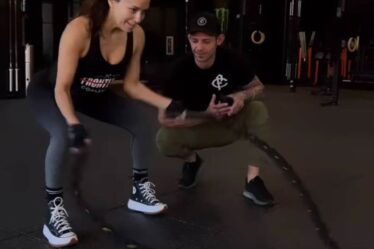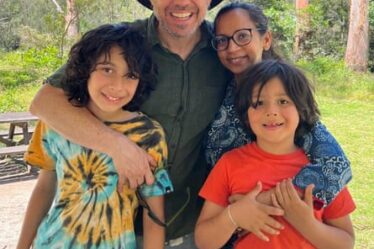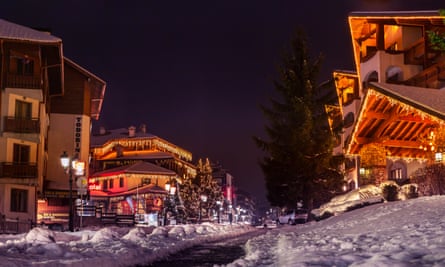
‘You lift one foot and you put it down,” says Alf, my guide. “Then you lift the other foot and you put it down.” For the newbies in our group – me included – these simple instructions are reassuring. At least snowshoeing has no complex manoeuvres to master; no vertical take-off, double-twist snowplough, or whatever it is that skiers get up to. You just strap on your strange footwear and walk. Phew.
The strapping on part has its challenges, though. As I crouch in a squall of windblown snow, my gloved fingers struggle to adjust the ratchet clasps. And when I finally get to my feet, I tread with one snowshoe on the rim of another and immediately hit the deck again. Alf hands me my poles. “Better not use the loops,” he says. “You might break your wrist.”
Thankfully, I have time to improve. It’s late March, and I’m in Bulgaria’s Pirin national park on a snowshoeing week with Ramble holidays. There are 10 of us, together with tour leader Alf Robertson – a lean, mountain-honed Aberdonian – and local guide Simeon Dimitrov. A quick glance suggests my companions are largely older than I am. They’re probably also fitter.
Our base for the first three nights is the historic town of Bansko, two hours south of Sofia and now a popular ski resort below the Pirin Mountains. On a quick stroll around the historic centre I spot the famous Sveta Troitsa orthodox church, complete with stork’s nest, but also an ominous bank of cloud cloaking the promised panorama. Over dinner, Alf confirms what any true rambler knows: that mountains are unpredictable, and itineraries must remain flexible. “It depends on the snowpack,” he says. “Too much snow can be dangerous.”
As it turns out, blue skies bless our first day and, instructions over, we are soon tramping up the trail. For the first kilometre, it follows a broad forest track, where the lighter snowfall allows us to feel our way into the new footwear. Soon, however, the trees thin out and we hit the virgin snow of the open slopes. Now, the snowshoes earn their keep, carrying us lightly over deep drifts that might otherwise swallow us whole.
Snowshoeing is knackering; let nobody tell you otherwise. Slogging uphill through snow at 2,000 metres, tests thighs and lungs. But we soon find our rhythm and, with confidence growing, I can at last look up, admire the soaring peaks and even pick out a handful of distant chamois. The only sounds are the creak and crunch of snow underfoot, and our own heavy breathing. When we stop, the stillness is impressive: bird calls carry up from the treeline with pin-sharp clarity.
Our destination is a frozen lake. But clouds sweep in, vindicating Alf’s caution, and after hurriedly munching packed lunches, we trudge back downhill through a white-out, barely able to see each other. Nonetheless, it’s a good first day. As we near the resort, hearing the thudding beat of après ski music and clamour of excited skiers, I feel a certain tortoise-beats-hare smugness; there are others way to enjoy the mountains than simply hurling yourself down them.
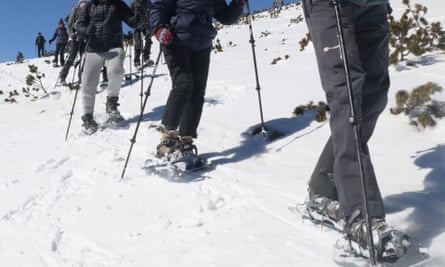
By the end of day two, we’ve got the snowshoes sussed. But on day three, we leave them behind and catch a train to Avramovo, the highest railway station in the Balkans, for a hike through the Rhodope mountains. This range extends east into Turkey, and its rural communities constitute the country’s Muslim heartland – the legacy of three centuries under Ottoman rule. From the sleepy village, with its gleaming minaret, we trek east along the Veliysko–Videnishko ridge, enjoying stirring views of the Pirin peaks to the south. Our trail remains below the snowline, but forest shadows hold the odd treacherous frozen patch.
Dinner that night is outside Bansko at the Deshka Guesthouse – a member of the Slow Food Association, which feels apt for snowshoers. At a large round table, we tuck into wholesome fare – banitsa, a layered dish of pastry, eggs and cheese, is especially delicious – and imbibe copious local wine. After dessert, our hosts play Bulgarian folk music, and persuade us to don traditional garments (for me, a nosia elek waistcoat and kalpak fur hat) and get up on our feet. The rakia helps and soon we’re all jigging around as though we hadn’t tramped 15km earlier today.
Day four sees us transfer north to the small village of Govedartsi, below the Rila mountains – our third Bulgarian range – for part two of our week. En route we visit Rila Monastery, Bulgaria’s most famous cultural attraction and the country’s spiritual heart. It is said to have been founded in the 10th century by the hermit St Ivan of Rila, who lived in a nearby cave. Inside, I admire the gold-plated iconostasis, behind which the hermit’s hand is said to be preserved.
Outside, the afternoon sun gilds the gleaming domes and columns, until the advancing mountain shadows swallow their lustre.
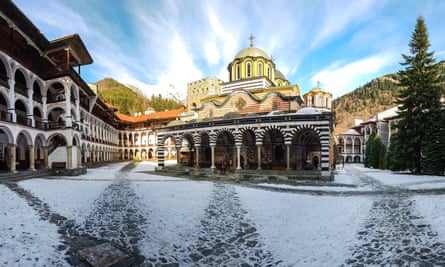
The snowshoeing continues in the Rila mountains, our exertions fuelled by home-cooked fare at the delightful, family-run Djambazki hotel, where we scoff local trout, baklava and breakfast pancakes (though not all at the same time) and are soothed with a visit to the hot springs in the spa town of Sapareva Banya. On our final day we are to tackle the Seven Rila Lakes circuit.
The day dawns with dazzling clarity – a landscape of freshly minted blues, greens and whites. We board a chairlift and ascend silently over slopes embroidered with the zigzag tracks of mountain hare and roe deer. On go the snowshoes and soon we’re falling into now-familiar rhythm, beetling steadily up inclines and along ridges. It takes two hours to reach the first of the lakes. Linked in summer by tumbling streams, they are now frozen solid, pancakes of white beneath the frosted cliffs of a grand natural amphitheatre. We squint beyond the snowfields to the distant green lowlands, as though looking from winter into spring. Faces are glowing. “This is as good as it gets,” says Alf. “It’s all downhill from here.”
Thankfully, I know exactly how to get downhill. You just lift one foot and you put it down, then you lift the other foot and you put it down.
Ramble Worldwide’s seven-night Snowshoeing in the Bulgarian Mountains from £1,350, half-board accommodation plus two lunches, all local transport, the services of a Ramble leader and English-speaking local snowshoeing guide throughout, and hire of snowshoes and poles. Next departure: 23 February 2024

